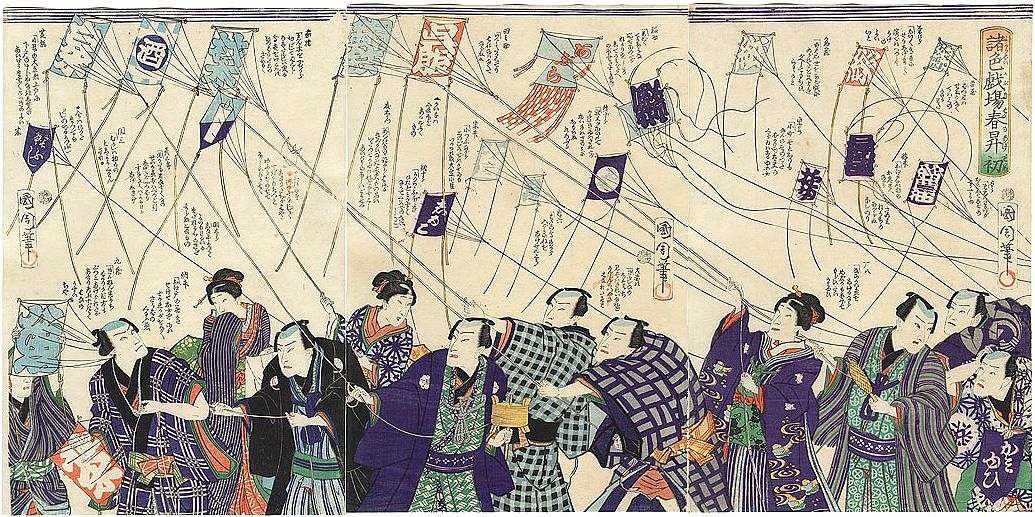| |
Kunichika
|

'Flying Kites in Early
Spring'
Colourful Fooling around on the Ground at Early Spring
(Shoshiki gijō haru nobori hatsu, 諸色戯場春昇初)
1866
The rising kites represent the rising prices during the 1866 season. The kabuki actors using kites, criticizing the shogunate for the price policy. The rising prices for the commodities are noted at any individual kite like "liquor" ("sake", "酒"), "cotton" (wata, 綿), "sushi" (sushi, すし), or "salt" (shio, 塩) etc.. Even the Japanese title of the triptych ("Colourful Fooling around on the Ground at Early Spring") must have been a provocation for the military government (shogunate). Despite the open critique, the censors approved the print with their seals.
Most kites are Edo kites ("Edo-tako", "江戸凧"), the majority bearing kanji characters ("Kanji kite", "ji tako", "字凧"). The left panel has two coat-of-arms kites ("Monshō-tako", "紋章凧"). Center panel upper part contains a Sode kite (sode-dako, 袖凧).
Series - ~
Artist - see Biography
Signature - "Kunichika hitzu" ("国周筆", drawn by Kunichika) on every panel (white cassettes) with his red ring seal (Otoshidama-in 年玉印). The circular seals adjoing KUNICHIKA's white signature cassettes on all three panels, are combined date-aratame censor seals (Keiō-2, correspondingly 1866 / XII, (Tora jū ni aratame, 寅十二改 )
Publisher - not classified;
Image Size - 72.7 X 36.2 cm (28 5/8" x 14 1/4") + margins as shown
Condition - triptych, three single panels; nishiki-e (cloured woodblock); Vertical ôban (ôban tate-e);
Colourful Fooling around on the Ground at Early Spring
(Shoshiki gijō haru nobori hatsu, 諸色戯場春昇初)
1866
Comment - Kabuki triptych showing a
group of men and women flying colorful kites in early spring.
The sky is crowded with fluttering kites, their tails waving
in the wind. Men and women (male kabuki actors) tug at the
strings with looks of intense concentration, watching their
kites rise the highest. At left, one of the beauties giggles
into her kimono sleeve as she watches.
During Keio 2 (1866) occured more than 70 riots, protesting not only the rising prices, but also demanding political reforms. Prices for everyday goods like rice led to a drastic rise, sometimes 10 times the price of 1859.
During Keio 2 (1866) occured more than 70 riots, protesting not only the rising prices, but also demanding political reforms. Prices for everyday goods like rice led to a drastic rise, sometimes 10 times the price of 1859.
The rising kites represent the rising prices during the 1866 season. The kabuki actors using kites, criticizing the shogunate for the price policy. The rising prices for the commodities are noted at any individual kite like "liquor" ("sake", "酒"), "cotton" (wata, 綿), "sushi" (sushi, すし), or "salt" (shio, 塩) etc.. Even the Japanese title of the triptych ("Colourful Fooling around on the Ground at Early Spring") must have been a provocation for the military government (shogunate). Despite the open critique, the censors approved the print with their seals.
Most kites are Edo kites ("Edo-tako", "江戸凧"), the majority bearing kanji characters ("Kanji kite", "ji tako", "字凧"). The left panel has two coat-of-arms kites ("Monshō-tako", "紋章凧"). Center panel upper part contains a Sode kite (sode-dako, 袖凧).
Series - ~
Artist - see Biography
Signature - "Kunichika hitzu" ("国周筆", drawn by Kunichika) on every panel (white cassettes) with his red ring seal (Otoshidama-in 年玉印). The circular seals adjoing KUNICHIKA's white signature cassettes on all three panels, are combined date-aratame censor seals (Keiō-2, correspondingly 1866 / XII, (Tora jū ni aratame, 寅十二改 )
Publisher - not classified;
Image Size - 72.7 X 36.2 cm (28 5/8" x 14 1/4") + margins as shown
Condition - triptych, three single panels; nishiki-e (cloured woodblock); Vertical ôban (ôban tate-e);
Copyright 2008 ff: Hans P. Boehme